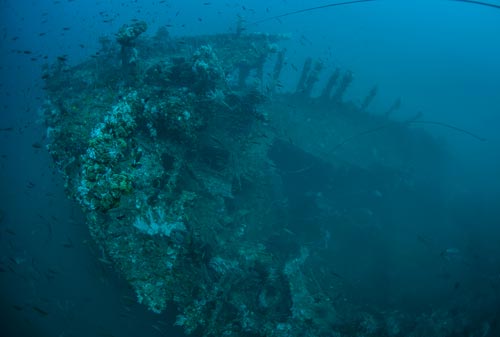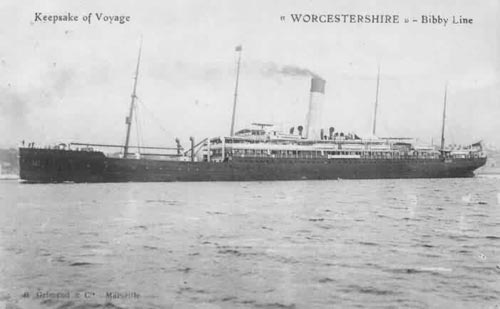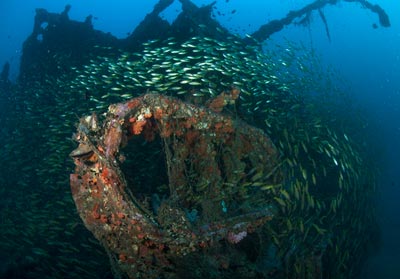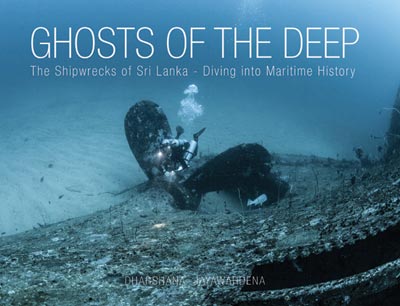Drawn to the depths

SS Worcestershire 2011 - First picture taken after it sank in 1917
The mystery, the history and the human stories of centuries gone by keep luring him on “solos” to the eerie deep, where many dare not venture.
Amidst many a danger, deep are the dives Dharshana Jayawardena undertakes in his quest for forgotten shipwrecks around Sri Lanka.
“It is a very spiritual experience like being in space,” is the simple explanation for this fascinating but dangerous hobby from Dharshana, a technical deep diver with more than 1,600 dives, sometimes to a depth of 70 metres (about 240 feet), to his credit. His regular job is as a software engineer.
Space has been his attraction from the time he was very young, with water being feared after a near-drowning in the Hakwetuna Oya in Kurunegala around the age of 13.

SS Worcestershire as it was
That was not the only “scary” experience – engaging in scuba try-dive while on holiday in Bermuda, when working in America, at 6m and after one hour feeling so claustrophobic (the sound of bubbles and the pressure of the water) that he had pleaded to be taken back up. It was August 2002. He was 30 at that time and could not even swim.
Surprisingly, Dharshana did not know how to swim because as a boy he was studious and a bookworm, with books on astronomy and cosmology shaping dreams of becoming an astronomer. He was an avid fan of the writings of Arthur C. Clarke and Isaac Asimov.
“I had a sense of failure over the Bermuda fiasco,” says Dharshana, which spurred him to undergo a four-day diving certification course in March 2003 in Sri Lanka…….intense training in a pool followed by the ocean, to come to grips with his fear. As he started breathing underwater, the fear vanished!
A few more dives and Dharshana began enjoying it as “it took on another life”.
How far he has dived, making it a passion, is obvious. Not just hobby diving but technical deep diving to unthinkable depths, lugging with him the life-saving cylinders of the tri-mix helium, nitrogen and oxygen. This is because nitrogen makes a diver drunk after 30m and causes narcosis (a state of stupor) at 60m, while oxygen becomes toxic at 65m and causes convulsions. Helium offsets these hazardous impacts.

SS Perseus, a WWI wreck: A shoal of Snappers envelop the stern
Going down is easy, he says, explaining that coming back up is fraught with danger for what has to be taken into consideration is ‘decompression illness’ (the bends), if there is a rapid decrease in the pressure of the water that surrounds the diver, if he surfaces too fast.
While this pioneering underwater explorer is an excellent underwater photographer and videographer, starting with a small hand-held camera and graduating onto more sophisticated equipment, international recognition has come in the form of the ‘Top 100’ Outstanding People in the Asian dive industry and, in 2019, the ADEX (Asian Dive Expo) Asian Explorer of the Year award.
He is a sought-after speaker at international scuba diving conventions and acts in an advisory capacity to many governmental and policy making bodies in Sri Lanka regarding shipwrecks and technical diving.

Dharshana Jayawardena
Dharshana’s eyes light up and his face becomes animated when we turn our attention to his deep dives and what he has found in the murky depths not touched by sunlight.
Too numerous to focus in one article (he has documented 50 in his book), he picks up three of his favourites, two being off Colombo, “an amazing place to dive”.
Curiosity is what drives him and he not only chats with fishermen but also gives ear to them. Admiralty charts meant for ships moving past Sri Lanka’s coastline, come in handy too to locate obstacles on the seabed which could be wrecks.
The first pointer towards an unidentified shipwreck 60m below off Mount Lavinia had come from fishermen. Usually, recreational divers go down to 18m, while advanced diving is to a maximum of 30m. Anything deeper than 40m needs more training and more equipment and is dubbed ‘technical diving’.
Getting dropped off by his boatman on the surface of the sea, when in 2009 Dharshana went down to 60m, only disappointment awaited him. It was just a sand hill on the seabed! In 2011, once again he had got a GPS (Global Positioning System) location from a fisherman that there was a deep wreck and down he had gone with a small sonar device on an exploratory dive 12km west of Mount Lavinia.
 “Very exciting,” had been the moment when he chanced upon the remains of a massive ship, a magical moment, all alone under the dark and eerie sea. This was the obsession that took him every week from 2011 to 2014 to the location, while googling and poring over material in a quest to identify this ghost.
“Very exciting,” had been the moment when he chanced upon the remains of a massive ship, a magical moment, all alone under the dark and eerie sea. This was the obsession that took him every week from 2011 to 2014 to the location, while googling and poring over material in a quest to identify this ghost.
History follows……….“It was the SS Worcestershire, a British armed merchant ship from World War I (WWI) which had been sent to a watery grave along with two crew members while en route from Rangoon to London on February 17, 1917, more than a hundred years ago.”
How did the tragedy occur? Dharshana says that there was a warship plying hither and thither in the Indian Ocean under the guise of a commerce raider, targeting Allied ships. It was the German SMS Wolf, preying on the busy South Africa-Ceylon-India-Malaysia-Indonesia-Australia route, which had sunk or captured 30 Allied ships and taken 400 prisoners between November 1916 and February 1918.
The proof that it was the SS Worcestershire Dharshana had unearthed when in 2013, diving from the stern of the ship, he found a pot which had the writing ‘Bibby Line’ which was the name of the company that owned the ship. A year later came the clincher, when he located the ship’s bell, stuck under the heavy metal of the collapsed forward mast, with the inscription ‘SS Worcestershire – Liverpool’.
The other was another British ship, the SS Perseus, lying silently at 40m off Modera, once again unique because it too was a WWI ship.
“The SS Worcestershire and SS Perseus are the only two WWI wrecks accessible by diving around Sri Lanka,” says Dharshana, adding that the dives to SS Perseus from 2014 to 2019 brought forth its bell in 2019.
Both bells are now with the Maritime Archaeology Unit.
Another highlight of his dives has been what followed after a fisherman contacted him in 2013 about an “unusual” metal piece which had got entangled in a net off Kalkudah in the east. Always ready to grab a challenge, a 42m dive had opened up an underwater crash site of a plane.
History buff that he is, Dharshana then dived into research and contacted experts to uncover the tale behind a WW2 Catalina amphibious craft of the Royal Air Force’s Dutch Squadron 321.
The Catalina, armed with depth charges against submarines and 11 crew members, had taken off from Minneriya on the afternoon of December 15, 1943 on a top secret mission. It was heading to the Andaman Islands in search of a Japanese submarine but as soon as it cleared Pasikudah, had crash-landed in the sea. With the crew clambering onto a single lifeboat for a 16-hour ride on choppy seas back to land, the Catalina had sunk to the seabed.
This Catalina with wheels was unique because only three such craft had been lost during the war, says Dharshana, appreciating the support extended by the Dutch Ambassador to verify the details.
A key feature in the identification that “nailed the evidence” was that when the Catalina’s left engine malfunctioned, one of its two propellers had “feathered” its blades (turning the blades to be parallel to the airflow to increase their angle).
For Dharshana, a poignant moment meanwhile, is linked to the world’s first purpose-built aircraft carrier, the HMS Hermes, sunk off Batticaloa, during WWII.
“The HMS Hermes wreck in which 307 people went down with the ship was discovered by diving legend Rodney Jonklaas in the 1960s. As my network across the world became bigger, three members of the HMS Hermes Association in the United Kingdom made a heartrending plea – to place flowers on the wreck in memory of their dads who had gone under,” says Dharshana who did just that in a dive in 2014.
Not only did he place a posy of white flowers on the wreck but also the notes they had penned…….sending photographs back to the daughters to hold close, shed a tear and reach closure about the deaths of their beloved fathers.
Additional reporting by Dilushi Wijesinghe
| The story of the wrecks | |
| Underwater explorer Dharshana Jayawardena’s second edition of ‘Ghosts of the Deep – Shipwrecks of Sri Lanka’ will roll off the presses on August 15.Targeting not only divers but also anyone interested in dipping their toes in marine history or archaeology, this coffee table book with stunning photographs and histories of the shipwrecks is priced at Rs. 19,000. It is available at the Vijitha Yapa Bookshops.
|
Searching for an ideal partner? Find your soul mate on Hitad.lk, Sri Lanka's favourite marriage proposals page. With Hitad.lk matrimonial advertisements you have access to thousands of ads from potential suitors who are looking for someone just like you.


